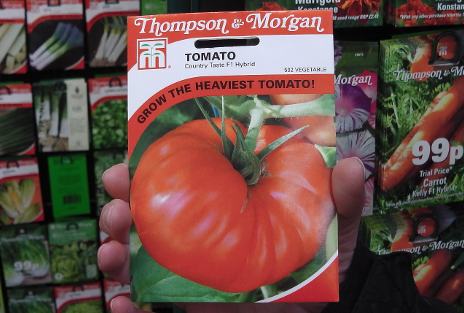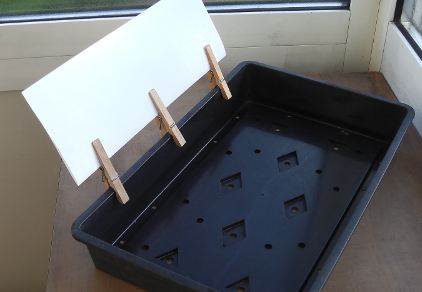Growing Large Varieties
I spend a lot of time talking about cherry varieties, mainly because they are the most likely to succeed in a poor summer. However, this week I’d like to talk about growing larger varieties.
There’s a real challenge for the tomato enthusiast when it comes to growing big tomatoes!
To grow a truss of large tomatoes, all of which ripen at the same size, takes a bit of experience – but don’t let that put you off! There are many great varieties that will grow successfully outdoors in the UK, such as Oregon Spring and Marmande, and many more suitable for the greenhouse, Now is a great time to sow them!
Here are my tips for growing large varieties
Truss pruning
One of the most important things to consider, is the amount of fruit to allow on each truss. As a general rule, the fewer the fruit, the more likely the toms are to reach their full potential and size.
Wait until the flowers have set, then keep your chosen amount and remove the rest of the flowers.
Feeding large varieties
Giving tomato plants a feed high in potassium, such as liquid tomato food, brings plants and tomatoes to maturity early.
Generally. in our short seasons, we feed as soon as the first truss starts to set fruit. This is fine for growing cherry tomatoes, but because more energy is needed to grow larger tomatoes, it is better to start feeding with a balanced feed until the second or third truss begins to set, then move to the tomato, high potash feed.
This prevents the tomatoes ripening before they reach their full size. The fact that we are pruning our trusses and have fewer tomatoes on our plants, helps the rate of growth and produces tomatoes of a more consistant size.
You wouldn’t go far wrong if you begin feeding with tomato food as in the following …
- Cherry tomatoes (with tomato food) when the first truss begins to set,
- Medium salad varieties when the second truss begins to set
- Larger varieties when the third truss begins to set.
The question then is … when do we start feeding with balanced food?
For grow bags and large pots, the soil contains around five or six weeks of nutrition. As soon as this period is complete, start feeding with balanced feed. Tomato food is then given when the third truss starts to set – if growing large vareties.
I hope that makes sense … more on feeding later in the season.
Support
Another consideration is support. The weight of a large tomato will damage the vine, so yoyo’s, string or a stocking are among the options to support the truss of fruit.
 Varieties to try
Varieties to try
There are so many great varieties in the beefsteak category and a number in the whopper category too!
One that you’ll find on seed displays is called Country Taste. It can grow to whopper size and is a good introduction to the world of the big tomato!
Big Boy and Big Daddy are two good choices as beefsteak varieties and both vigorous hybrids.
Brandywine and Caspian Pink are two heirloom varieties that have a reputation for taste – though it’s difficult to achieve their full taste in a UK summer.
There’s a true whopper available called “Gigantomo” that holds the world record of 7lbs 12oz.
Photosynthesis and Tomato Plants
Last week we talked about air movement for transpiration, reducing condensation and helping to prevent diseases.
This week I want to mention the importance of reflected light and air movement for photosynthesis.
Here’s a bit of theory and also some practical tips that we can apply.
Photosynthesis is the way plants make sugars in their leaves for energy – they use:
- Light – directly or indirectly from the sun
- Water – usually from the soil – it’s best to keep water off the leaves unless you are foliar feeding
- Carbon dioxide absorbed through leaves – from the air around them.
If one of these is in short supply, growth will slow down. This is known as the “limiting factor”.
It’s easy to provide the water, but providing enough light and carbon dioxide is more challenging.
Light
When we get a poor season – more clouds than sun – even cherry varieties struggle to produce a good crop, let alone the medium and beefsteak varieties.
Tomatoes don’t need full sun all day for photosynthesis and to produce a good crop. However, they do need plenty of light and all the reflected light available.
White reflective surfaces increase yield and can be used from the seedling stage to mature fruiting plants. Even a sheet of white paper behind a tray of seedlings helps!

In the greenhouse, porch and on the windowsill, aeration (air flow) helps to make carbon dioxide available as air moves over a plant’s leaves.
A sealed greenhouse full of tomato plants, with no air movement, will use-up the available carbon dioxide and growth will be reduced – carbon dioxide will then become the limiting factor.
To sum up
Use reflective material as much as possible throughout plant growth. Use white plastic sheeting and sheets of paper behind seedlings. Also, hope for a sunny bright summer!
Keep the air circulating in the greenhouse – it’s better for temperature to be reduced slightly than to have a greenhouse full of condensation and plants unable to absorb enough carbon dioxide.
The reduced air flow and humidity will also cause transpiration to slow (leaves won’t be able to release moisture) and that can cause Blossom End Rot as calcium uptake is reduced.
My first season
My first season was very successful – I knew very little about growing tomatoes but thankfully all went well.
The following two or three seasons where a disaster. I became hooked on growing tomatoes and killed my poor plants with kindness – and gave them every extra tip and additive I could find, thinking I was doing my plants a favour!
The moral of the story is not to get too technical too soon, stick to the basics, experiment a little, expect a few failures and most of all enjoy your tomato growing!
Back next week – I hope that your seedlings are doing well!
Cheers,
Nick
PS As soon as your seedlings come through, get them into the light as soon as possible to avoid legginess.
Email: [email protected]
Facebook Page: https://www.facebook.com/tomatogrowing/
Facebook Group: https://www.facebook.com/groups/216375252171863/
Links to supplies…
Tomato Seeds, Propagators, Jiffy 7 Pellets, Jiffys in Wilco, Rootit Sponges, Grow Lights.
Nick’s Technical Tomato PDF Ebook

John Barrett
Nick
I have a lot of old CDs/DVDs that I use around the base of plants, they reflect a lot of light upwards onto the bottom leaves plus they do not mind a bit of water. I wash them at the start of each season and they last a good few years.
Nick
Hi John,
Great idea!
Valerie
Good morning Nick.As usual a Saturday morning breakfast treat!
For the last two years I have used Quadgrows for my toms.I suppose this is a form of hydroponics but this year I would like to try the real thing by growning bush tomatoes outside in buckets with lids,a bit like a SIP but without the soil. The examples of hydroponics that I have seen involve a pump to keep the water circulating.Is this essential or is there some other way to provide aeration?
Nick
Hi Valerie, Sorry I’m late with the reply, for some reason I missed your comment.
The most important thing is to keep the reservoir light-proof to prevent algae.
Using a fish tank air pump is ideal for oxygenating the water/nutrient solution but it is not essential.
I’ve grown tomatoes sat on buckets and it work very well – similar to the Quadgrow but for single plants.